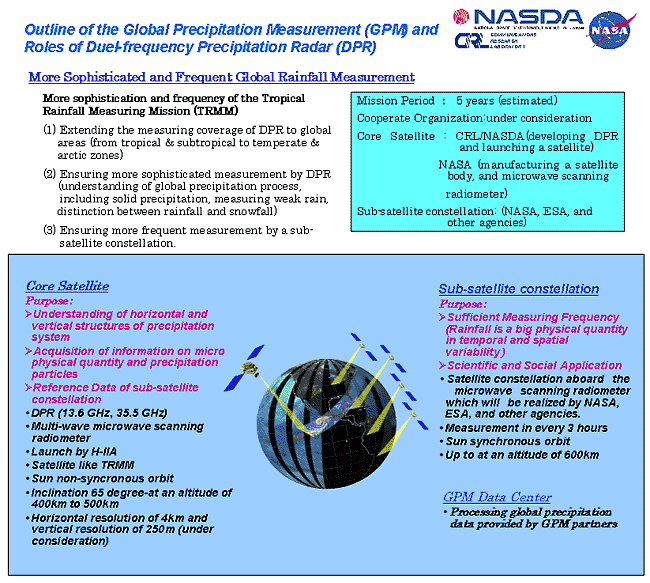Symposium on the Global Precipitation Measurement (GPM)
National Space Development Agency of Japan
The National Space Development Agency of Japan (NASDA), the Communications Research Laboratory (CRL) and the National Aeronautics and Space Administration (NASA) will have the symposium on the Global Precipitation Measurement (GPM) on November 9 (Friday).
GPM is a follow-on and expanded mission of the current on-going Tropical Rainfall Measuring Mission (TRMM). It is a earth observation satellite program for the expansion of observing areas (from the tropical to the global area), the improvement of observing frequency (drafting an global precipitation map in every three hours) and the enhancement of measuring methods (identifying rain and snow using the dual-frequency precipitation radar (DPR) and improving a rainfall estimation). The data acquired by GPM is expected to be useful for monitoring and predicting meteorological changes including global warming in the long term, and for responding to social needs such as weather forecast, water resource management in the short term.
This symposium is held at 13:30 at Chiyoda Hoso Kaikan (Tokyo) to develop GPM's objectives and missions and to enhance public understanding of its expected results.
Those who are interested in the Symposium are all welcomed and contact us for more information.
|
|
Program
| Date: | November 9 (Friday), 2001 13:30 - 17:15 | ||||||||||||||||||||||||||
| Venue: | Chiyoda Hoso Kaikan 1-1 Kioi-cho, Chiyoda-ku, Tokyo, Japan | ||||||||||||||||||||||||||
| M.C.: |
Mr. Nobuharu Masuko (CRL) Ms. Riko Oki (NASDA)
|
||||||||||||||||||||||||||
|
|||||||||||||||||||||||||||
Outline of the Global Precipitation Measurement (GPM) and Roles of Dual-frequency Precipitation Radar (DPR)

Summary of the Global Precipitation Measurement (GPM)
|
|
The Global Precipitation Measurement (GPM) is a follow-on and expanded mission of the current on-going Tropical Rainfall Measuring Mission (TRMM). GPM is one of the earth observation satellite programs, mainly initiated by the National Space Development Agency of Japan (NASDA), the Communications Research Laboratory (CRL) and the National Aeronautics and Space Administration (NASA). |
|
|
TRMM, a joint project between Japan and the United States, is to observe the precipitation situation in tropical regions which are regarded as a main driving force for global atmospheric circulation. GPM has been doing the scientific and technological work that TRMM made successfully and aims at observing further frequent precipitation measurement in extensive area including high latitudes, which TRMM cannot cover. Rainfall is part of the hydrological circle and indispensable to human life. It is very important to elucidate its real state in terms of maintaining water resources. In addition, rainfall is an indicator of global climatic change including global warming, so that measuring rainfall will contribute to more understanding of the climatic change mechanism. |
|
|
GPM is, like TRMM, composed of one sun non-synchronous orbit satellite (a core satellite)-borne a precipitation radar and a microwave scanning radiometer, and more than one sun synchronous orbit satellite-borne a microwave scanning radiometer (constellation of sub-satellites). |
|
|
The core satellite is expected to be able to measure detailed precipitation activities, using both of the dual-frequency precipitation radar and the microwave scanning radiometer. The data acquired by such measurement will permit of sophisticating the presumed algorithm of quantitative rain measurement in the microwave scanning radiometer. The sub-satellite will conduct the precipitation measurement of the microwave scanning radiometer and the measurement will become more reliable by utilizing the presumed algorithm. |
|
|
The sub-satellite constellation will be launched by NASA, European Space Agency (ESA) and other space organizations in the world. The number of satellites will be around eight. It is possible to get a global rainfall distribution in every 3 hours when the microwave scanning radiometers aboard these 8 polar orbit satellites collect and process the data. GPM plans real-time transmission of the global rainfall distribution data. This real-time data can be utilized not only for scientific research, but for social fields, including weather forecast, flood prediction, water resource management. |